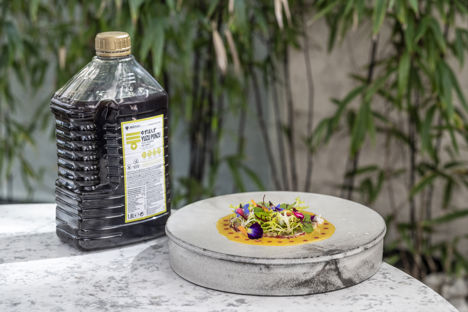
Ingredient focus: yuzu ponzu
Ponzus flavoured with the likes of yuzu are said to have played an important role Japanese cookery for centuries but are now increasingly being used by a variety of pan-Asian chefs. We take a closer look at this versatile condiment and how it’s now more convenient than ever to use, thanks to bottled products.
Ingredient focus: yuzu ponzu
Ponzus flavoured with the likes of yuzu are said to have played an important role Japanese cookery for centuries but are now increasingly being used by a variety of pan-Asian chefs. We take a closer look at this versatile condiment and how it’s now more convenient than ever to use, thanks to bottled products.
Bursting full of both fresh citrus notes and deep umami, yuzu ponzu has been a hugely popular condiment amongst Japanese chefs for hundreds of years, and is used to enhance the flavour of all sorts of classic dishes. Yet the potential of yuzu ponzu stretches far beyond the bounds of the Japanese kitchen, with chefs now using it in a whole host of different cuisines. Whilst yuzu ponzu can be made from scratch, the fast-paced nature of modern kitchens mean that ready-to-use products can be far more convenient. That’s what makes products like Mizkan’s beautifully balanced yuzu ponzu such a useful ingredient for pan-Asian chefs wanting to quickly add some oomph to a dish.
The key ingredients used to make yuzu ponzu are soy sauce and, of course, yuzu juice, which need to be carefully combined to create something that’s equally acidic and rich in umami. For a chef though, the difficulty comes in creating a yuzu ponzu that has a consistent flavour profile. Mizkan’s bottled yuzu ponzu has all the citrus umami you’d expect from a scratch-made yuzu ponzu, as well a balance of acidity and savouriness, but has the benefit of requiring no preparation.
Masaki Sugisaki, executive chef at the renowned Dinings SW3, may be a traditionally trained Japanese chef but over the years has adopted a more fusion-led approach to the cuisine, taking influence from across the globe whilst still using plenty of Japanese ingredients. After using Mizkan’s yuzu ponzu in some recently developed recipes, Masaki was particularly impressed by the balance of the product. ‘In a domestic kitchen you’re used to using products that aren’t made from scratch,’ he explains. ‘But Mizkan’s product is already perfectly balanced, so it can easily be used in a professional kitchen too. It is strong so you have to be careful when playing with delicate ingredients like white fish sashimi, but all the key elements I’d look for are there – acidy, citrussy notes, umami and also a bit of sweetness.’
Some people think of yuzu ponzu as a condiment, while others might regard it as a sauce but the fact of the matter is that it can be used in a number of different ways, as Masaki recognises. ‘It’s definitely very versatile,’ he says. ‘But overall, it’s just a great way of dialling up certain flavours.’ This versatility is brilliantly showcased by Masaki’s two recipes – a native lobster carpaccio dish, seasoned with yuzu ponzu and served with both a yuzu ponzu salsa and a yuzu Amarillo vinaigrette, and a cold udon noodle dish served with chicken steamed in sake, shio koji and yuzu ponzu and a yuzu tahini vinaigrette.
Every chef has a different way of working when it comes to creating new dishes but Masaki’s ethos is all about ‘less is more’, so he wanted the yuzu ponzu to form a core part of the dish rather than it being one of many elements which don’t work together. ‘My aim is to not mix up too many ingredients,’ he explains. ‘Otherwise, they can all just overpower each other. So, I just tried to stick to the yuzu flavour as much as possible.’
His two recipes may feature contrasting styles of vinaigrette, both made using Mizkan’s yuzu ponzu, but they also demonstrate how the product can both be used in both cold and hot elements of a dish; whilst the lobster carpaccio is delicately dressed with a seasoning made from the yuzu ponzu, the chicken served with the udon noodles is actually steamed in it, to give further flavour to the meat. In both recipes Masaki has also used yuzu koshō as a contrasting flavour. ‘In a way, this yuzu ponzu is quite a deep flavour but it’s also got sweetness,’ he explains. ‘So, I balanced that with yuzu koshō, which has a really spicy kick but also a salty flavour.’
Masaki’s two recipes may be perfect for spring and summertime, but the Japanese chef also adds that yuzu ponzu can be used throughout the year. ‘It definitely also works really well in hot dishes,’ says Masaki. ‘In wintertime, for instance, we have a hot pot style dish in Japan with Chinese cabbage, spring onions, and tofu braised in a kombu broth. This yuzu ponzu would work perfectly in a simple dish like that.’
Yuzu ponzu may have been produced for many years, but chefs like Masaki are proving that not only are there still innovative ways of using it to enhance flavours in pan-Asian cookery more broadly, but it’s now more convenient than ever, thanks to the likes of Mizkan. Their carefully balanced yuzu ponzu guarantees chefs consistency both in terms of flavour profile and quality, whilst saving them precious time; and in the professional kitchen that really is invaluable.

